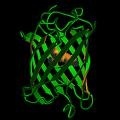The potential of green protein
GFPs not only help cell function studies but also hold promise for tumour surgery
Professor Roger Tsien, Nobel Laureate in Chemistry 2008 for the ‘Discovery and Development of Green Fluorescent Proteins’, was one three* Keynote Speakers at the opening ceremony of the Medical Physics and Bioengineering World Congress 2009, held in Munich this September.

The discovery off GFPs helps researchers to study cell function. Describing his work, Prof. Tsien said: ‘I develop molecules to look into the inside of cells, to look at things that are beyond the human eye’. Briefly, the aim is to develop colourants that can penetrate cell tissue without impacting on cell functions or even destroying cells; this provides completely new opportunities to study cell functions.
Prof. Tsien and his research team modified GFP, which naturally occurs in jellyfish, as well as red fluorescent coral protein to observe numerous cell activities, such as cell division. The professor’s methods have led to new approaches in simultaneous visualisation of different molecular processes without impacting cell function.
Also among his research fields is Molecular Fluorescence Guided Surgery, which involves administering to patients synthetically developed fluorescent proteins that are significantly smaller than the GFPs found in jellyfish, so that they can accumulate in tumour tissue.
To demonstrate the effect, Prof. Tsien showed images of a marked tumour. Although with a normal surgical operating lamp the surgeon has an optimum view of the tumour, its outline cannot be determined precisely, which is vital for a complete resection. The protein fluorescence of the marked tumour is best visible in the dark, but this means the operating area is not clearly visible. With the help of stroboscopic lighting within the operating site it is possible to provide the surgeon with an overlay of both images. The tumour tissue lights up green and then can be removed precisely.
Prof. Tsien believes this approach has considerable potential.
* Keynote speakers included Dr Annette Schavan, Federal Minister of Education and Research and Professor Hermann Requardt, CEO of the Siemens Healthcare Sector, member of the Managing Board and Chief Technology Officer of Siemens AG.
16.11.2009










